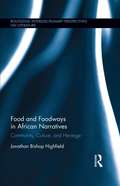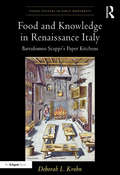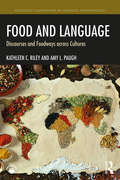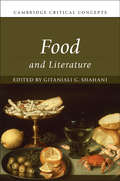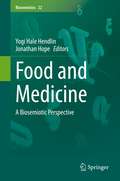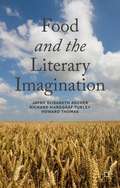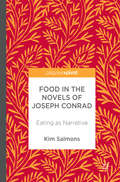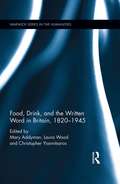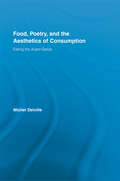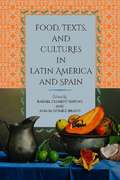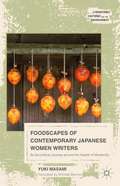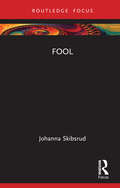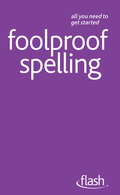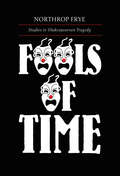- Table View
- List View
Food and Femininity in Twentieth-Century British Women's Fiction
by Andrea AdolphIn her feminist intervention into the ways in which British women novelists explore and challenge the limitations of the mind-body binary historically linked to constructions of femininity, Andrea Adolph examines female characters in novels by Barbara Pym, Angela Carter, Helen Dunmore, Helen Fielding, and Rachel Cusk. Adolph focuses on how women's relationships to food (cooking, eating, serving) are used to locate women's embodiment within the everyday and also reveal the writers' commitment to portraying a unified female subject. For example, using food and food consumption as a lens highlights how women writers have used food as a trope that illustrates the interconnectedness of sex and gender with issues of sexuality, social class, and subjectivity-all aspects that fall along a continuum of experience in which the intellect and the physical body are mutually complicit. Historically grounded in representations of women in periodicals, housekeeping and cooking manuals, and health and beauty books, Adolph's theoretically informed study complicates our understanding of how women's social and cultural roles are intricately connected to issues of food and food consumption.
Food and Foodways in African Narratives: Community, Culture, and Heritage (Routledge Interdisciplinary Perspectives on Literature)
by Jonathan Bishop HighfieldFood is a defining feature in every culture. Despite its very basic purpose of sustaining life, it directly impacts the community, culture and heritage in every region around the globe in countless seen and unseen ways, including the literature and narratives of each region. Across the African continent, food and foodways, which refer to the ways that humans consume, produce and experience food, were influened by slavery and forced labor, colonization, foreign aid, and the anxieties prompted by these encounters, all of which can be traced through the ways food is seen in narratives by African and colonial storytellers. The African continent is home to thousands of cultures, but nearly every one has experienced alteration of its foodways because of slavery, transcontinental trade, and colonization. Food and Foodways in African Narratives: Community, Culture, and Heritage takes a careful look at these alterations as seen through African narratives throughout various cultures and spanning centuries.
Food and Knowledge in Renaissance Italy: Bartolomeo Scappi's Paper Kitchens (Visual Culture In Early Modernity Ser.)
by Deborah L KrohnThough Bartolomeo Scappi's Opera (1570), the first illustrated cookbook, is well known to historians of food, up to now there has been no study of its illustrations, unique in printed books through the early seventeenth century. In Food and Knowledge in Renaissance Italy, Krohn both treats the illustrations in Scappi's cookbook as visual evidence for a lost material reality; and through the illustrations, including several newly-discovered hand-colored examples, connects Scappi's Opera with other types of late Renaissance illustrated books. What emerges from both of these approaches is a new way of thinking about the place of cookbooks in the history of knowledge. Krohn argues that with the increasing professionalization of many skills and trades, Scappi was at the vanguard of a new way of looking not just at the kitchen-as workshop or laboratory-but at the ways in which artisanal knowledge was visualized and disseminated by a range of craftsmen, from engineers to architects. The recipes in Scappi's Opera belong on the one hand to a genre of cookery books, household manuals, and courtesy books that was well established by the middle of the sixteenth century, but the illustrations suggest connections to an entirely different and emergent world of knowledge. It is through study of the illustrations that these connections are discerned, explained, and interpreted. As one of the most important cookbooks for early modern Europe, the time is ripe for a focused study of Scappi's Opera in the various contexts in which Krohn frames it: book history, antiquarianism, and visual studies.
Food and Language: Discourses and Foodways across Cultures
by Amy L. Paugh Kathleen C. RileyFood and Language: Discourses and Foodways across Cultures explores in innovative ways how food and language are intertwined across cultures and social settings. How do we talk about food? How do we interact in its presence? How do we use food to communicate? And how does social interaction feed us? The book assumes no previous linguistic or anthropological knowledge but provides readers with the understanding to pursue further research on the subject. With a full glossary at the end of the book and additional tools hosted on an eResources page (such as recommended web and video links and some suggested research exercises), this book serves as an ideal introduction for courses on food, language, and food-and-language in anthropology departments, linguistics departments, and across the humanities and social sciences. It will also appeal to any reader interested in the semiotic interplay between food and language.
Food and Literature (Cambridge Critical Concepts)
by Gitanjali G. ShahaniThis volume examines food as subject, form, landscape, polemic, and aesthetic statement in literature. With essays analyzing food and race, queer food, intoxicated poets, avant-garde food writing, vegetarianism, the recipe, the supermarket, food comics, and vampiric eating, this collection brings together fascinating work from leading scholars in the field. It is the first volume to offer an overview of literary food studies and reflect on its origins, developments, and applications. Taking up maxims such as 'we are what we eat', it traces the origins of literary food studies and examines key questions in cultural texts from different global literary traditions. It charts the trajectories of the field in relation to work in critical race studies, postcolonial studies, and children's literature, positing an omnivorous method for the field at large.
Food and Medicine: A Biosemiotic Perspective (Biosemiotics #22)
by Jonathan Hope Yogi Hale HendlinThis edited volume provides a biosemiotic analysis of the ecological relationship between food and medicine. Drawing on the origins of semiotics in medicine, this collection proposes innovative ways of considering aliments and treatments. Considering the ever-evolving character of our understanding of meaning-making in biology, and considering the keen popular interest in issues relating to food and medicines - fueled by an increasing body of interdisciplinary knowledge - the contributions here provide diverse insights and arguments into the larger ecology of organisms’ engagement with and transformation through taking in matter. Bodies interpret molecules, enzymes, and alkaloids they intentionally and unintentionally come in contact with according to their pre-existing receptors. But their receptors are also changed by the experience. Once the body has identified a particular substance, it responds by initiating semiotic sequences and negotiations that fulfill vital functions for the organism at macro-, meso-, and micro-scales. Human abilities to distill and extract the living world into highly refined foods and medicines, however, have created substances far more potent than their counterparts in our historical evolution. Many of these substances also lack certain accompanying proteins, enzymes, and alkaloids that otherwise aid digestion or protect against side-effects in active extracted chemicals. Human biology has yet to catch up with human inventions such as supernormal foods and medicines that may flood receptors, overwhelming the body’s normal satiation mechanisms. This volume discusses how biosemioticians can come to terms with these networks of meaning, providing a valuable and provocative compendium for semioticians, medical researchers and practitioners, sociologists, cultural theorists, bioethicists and scholars investigating the interdisciplinary questions stemming from food and medicine.
Food and the Literary Imagination
by Jayne Elisabeth ArcherFood and the Literary Imagination explores ways in which the food chain and anxieties about its corruption and disruption are represented in poetry, theatre and the novel. The book relates its findings to contemporary concerns about food security.
Food in Margaret Atwood’s Speculative Fiction
by Katarina LabudovaThis book looks at Margaret Atwood’s use of food motifs in speculative fiction. Focusing on six novels – The Handmaid’s Tale and The Testaments, the Maddaddam trilogy, and The Heart Goes Last – Katarina Labudova explores the environmental, ecological, and cultural questions at play and the possible future scenarios which emerge for humanity’s survival in apocalyptic and post-apocalyptic conditions. Labudova argues that food has special relevance in these novels and that characters’ hunger, limited food choices, culinary creativity and eating rituals are central to Atwood’s depictions of hostile environments. She also links food to hierarchy, dominance and oppression in Atwood’s novels, and foregrounds the problem of hunger, both psychological or physical, caused by pollution and loss of contact with the natural and authentic. The book shows how Atwood’s writing draws from a range of genres, including apocalyptic fiction, science fiction, speculative fiction, dystopia, utopia, fairy tale, myth, and thriller – and how food is an important, highly versatile motif linking these intertextual threads.
Food in Shakespeare: Early Modern Dietaries and the Plays (Literary And Scientific Cultures Of Early Modernity Ser.)
by Joan FitzpatrickA study of common and exotic food in Shakespeare's plays, this is the first book to explore early modern English dietary literature to understand better the significance of food in Shakespearean drama. Food in Shakespeare provides for modern readers and audiences an historically accurate account of the range of, and conflicts between, contemporary ideas that informed the representations of food in the plays. It also focuses on the social and moral implications of familiar and strange foodstuff in Shakespeare's works. This new approach provides substantial fresh readings of Hamlet, Macbeth, As you Like It, The Winter's Tale, Henry IV Parts 1 and 2, Henry V, Titus Andronicus, Coriolanus, Pericles, Timon of Athens, and the co-authored Sir Thomas More. Among the dietaries explored are Andrew Boorde's A Compendyous Regyment or a Dyetary of Healthe (1547), William Bullein's The Gouernement of Healthe (1595), Thomas Elyot's The Castle of Helthe (1595) and Thomas Cogan's The Hauen of Health (1636). These dieteries were republished several times in the early modern period; together they typify the genre's condemnation of surfeit and the tendency to blame human disease on feeding practices. This study directs scholarly attention to the importance of early modern dietaries, analyzing their role in wider culture as well as their intersection with dramatic art. In the dietaries food and drink are indices of one's position in relation to complex ideas about rank, nationality, and spiritual well-being; careful consumption might correct moral as well as physical shortcomings. The dietaries are an eclectic genre: some contain recipes for the reader to try, others give tips on more general lifestyle choices, but all offer advice on how to maintain good health via diet. Although some are more stern and humourless than others, the overwhelming impression is that of food as an ally in the battle against disease and ill-health as well as a potential enemy.
Food in the Middle Ages: A Book of Essays (Medieval Casebooks Series #12)
by Melitta Weiss AdamsonFirst Published in 1995. Routledge is an imprint of Taylor & Francis, an informa company.
Food in the Novels of Joseph Conrad
by Kim SalmonsThis book is about the role of food in the works of Joseph Conrad, analysing the social, political and anthropological context of references to meals, eating, food production and cannibalism. It offers a new perspective on the works of Joseph Conrad and provides an accessible medium through which readers can engage with the complex theories and philosophical dilemmas that Conrad presents in his fiction. This is the only major study of food in Conrad's works; it is unique in its interdisciplinary approach to food in that it engages with sociological, political, historical, personal and literary perspectives, thus providing a multi-dimensional approach to cultural, revolutionary, periodical and fictional representations of the late nineteenth and early twentieth centuries. This in turn, allows an interrogation of modern anxieties, embedded in cultural norms and values that can be interpreted through the way that food is prepared and eaten.
Food, Consumption, and Masculinity in American Hardboiled Fiction (Crime Files)
by Marta UsiekniewiczFood, Consumption, and Masculinity in American Hardboiled Fiction draws on three related bodies of knowledge: crime fiction criticism, masculinity studies, and the cultural analysis of food and consumption practices from a critical eating studies perspective. In particular, this book focuses on food as an analytical category in the study of tough masculinity as represented in American hardboiled fiction. Through an examination of six American novels: Dashiell Hammett's The Maltese Falcon, Raymond Chandler's The Big Sleep, Leigh Brackett's No Good from a Corpse, Dorothy B. Hughes's In a Lonely Place, Jim Thompson's The Killer Inside Me, and Rex Stout's Champagne for One, this book shows how these novels reflect the gradual process of redefining consumption and consumerism in America, which traditionally has been coded as feminine. Marta Usiekniewicz shows that food and eating also reflect power relations and larger social and economic structures connected to class, gender, geography, sexuality, and ability, to name just a few.
Food, Drink, and the Written Word in Britain, 1820-1945 (Warwick Series in the Humanities)
by Laura Wood Mary Addyman Christopher YiannitsarosThis volume explores the intersection between culinary history and literature across a period of profound social and cultural change. Split into four parts, essays focus on the relationships between eating and childhood reading in the Victorian era, the role of hunger in depicting social instability and reform, the cultivation of taste through advertising and the formation of cultural legacies through imaginative and emotional experiences of food and drink. Contributors show that studying consumption is necessary for a full understanding of class, gender, national identity and the body. The works of writers such as Elizabeth Gaskell, Edward Lear, Isabella Beeton and Bram Stoker are considered alongside advice manuals, Home Front narratives and advertising to provide an innovative work that will be of interest to scholars of social, cultural and medical history as well as literary studies.
Food, Poetry, and the Aesthetics of Consumption: Eating the Avant-Garde (Routledge Studies in Twentieth-Century Literature)
by Michel DelvilleFrom Plato’s dismissal of food as a distraction from thought to Kant’s relegation of the palate to the bottom of the hierarchy of the senses, the sense of taste has consistently been devalued by Western aesthetics. Kant is often invoked as evidence that philosophers consider taste as an inferior sense because it belongs to the realm of the private and subjective and does not seem to be required in the development of higher types of knowledge. From a gastrosophical perspective, however, what Kant perceives as a limitation becomes a new field of enquiry that investigates the dialectics of diet and discourse, self and matter, inside and outside. The essays in this book examine the importance of food as a pivotal element – both materially and conceptually – in the history of the Western avant-garde. From Gertrude Stein to Alain Robbe-Grillet and Samuel Beckett, from F.T. Marinetti to Andy Warhol, from Marcel Duchamp to Eleanor Antin, the examples chosen explore the conjunction of art and foodstuff in ways that interrogate contemporary notions of the body, language, and subjectivity.
Food, Texts, and Cultures in Latin America and Spain
by Rafael Climent-Espino Ana M. Gómez-BravoThe fourteen essays in Food, Texts, and Cultures in Latin America and Spain showcase the eye-opening potential of a food lens within colonial studies, ethnic and racial studies, gender and sexuality studies, and studies of power dynamics, nationalisms and nation building, theories of embodiment, and identity. In short, Food, Texts, and Cultures in Latin America and Spain grapples with an emerging field in need of a foundational text, and does so from multiple angles. The studies span from the Middle Ages to the twenty-first century, and the contributing scholars occupy diverse fields within Latin American and Hispanic Studies. As such, their essays showcase eclectic critical and theoretical approaches to the subject of Latin American and Iberian food.Food, Texts, and Cultures in Latin America and Spain also introduces the first English-language publication of works from such award-winning scholars as Adolfo Castañón of the Mexican Academy of Language; Sergio Ramírez, winner of the 2017 Miguel de Cervantes Prize in Literature; and Carmen Simón Palmer, winner of the 2015 Julián Marías Prize for Research.
Food, Texts, and Cultures in Latin America and Spain
by Rafael Climent-Espino and Ana M. Gómez-BravoA foundational text in the emerging field of Latin American and Iberian food studies
Foodscapes of Contemporary Japanese Women Writers
by Yuki MasamiFood binds us to each other and to the environment. The ways, however, that food brings together various forms of life transforms in different times and places. Here, Yuki explores the logics and systems of value that surround food consumption, distribution, and production as expressed in the works of four female Japanese authors: Ishimure Michiko, Taguchi Randy, Morisaki Kazue, and Nashiki Kaho. Yuki uses interviews and socially informed literary analysis to weave together multiple voicesand perspectives to answer to the following questions: Why do some people knowingly eat contaminated food? How have the commodification and quantification of food affected our social and environmental relations? How has the meaning of making and sharing food changed and for whom? And how are changing relations to food affected by changing relations of language to meaning? This book is of interest to scholars of food studies, environmental studies, ecocriticism, modernity, Japan and Japanese literature.
Fool (New Literary Theory)
by Johanna SkibsrudCombining personal narrative, interviews, and literary analysis, Fool elaborates the potential for fool figures from throughout literary history to reconfigure subject-object relations and point towards new possibilities in creative and critical thought. Drawing on Johanna Skibsrud’s experience in clown classes in France and the US, Fool challenges and extends the correlation Theodor Adorno suggests between thinking and clowning. It considers a diverse range of literary and theoretical sources from Richard Wagner’s Parsifal to Karen Barad’s Meeting the Universe Halfway. The book also refers to a varied cast of literary and historical clowns and fools, including the early Shakespearean actor Richard Tarlton, Alban Berg’s Wozzeck, and Cirque du Soleil’s Shannan Calcutt. Skibsrud elaborates on the role of the ‘fool’ and ‘foolishness’ in literature, not as an element of a particular work’s content, plot, or style but instead as a creative mode of thought activated through the reading and writing of literary texts. This innovative book charts new ground in literature, philosophy, and performance studies, and is an invaluable resource for specialists in all three fields.
Fool For Love (SparkNotes Literature Guide Series)
by SparkNotesFool For Love (SparkNotes Literature Guide) by Sam Shepard Making the reading experience fun! Created by Harvard students for students everywhere, SparkNotes is a new breed of study guide: smarter, better, faster.Geared to what today's students need to know, SparkNotes provides:chapter-by-chapter analysis explanations of key themes, motifs, and symbols a review quiz and essay topics Lively and accessible, these guides are perfect for late-night studying and writing papers.
Fool's Talk: Recovering the Art of Christian Persuasion
by Os GuinnessChristianity TodayOne of Desiring God's Top 15 Books of 2015Hearts Minds Bookstore's Best Books of 2015, Social Criticism and Cultural Engagement
Foolproof Spelling: Flash
by Elspeth SummersThe books in this bite-sized new series contain no complicated techniques or tricky materials, making them ideal for the busy, the time-pressured or the merely curious. Foolproof Spelling is a short, simple and to-the-point guide to learning the basic principles of correct spelling in a few short steps. Whether to brush up on writing skills, do better in exams or simply to feel more confident, in just 96 pages you will discover how to master the essential rules and feel more in control of their writing.
Foolproof Spelling: Flash
by Elspeth SummersThe books in this bite-sized new series contain no complicated techniques or tricky materials, making them ideal for the busy, the time-pressured or the merely curious. Foolproof Spelling is a short, simple and to-the-point guide to learning the basic principles of correct spelling in a few short steps. Whether to brush up on writing skills, do better in exams or simply to feel more confident, in just 96 pages you will discover how to master the essential rules and feel more in control of their writing.
Fools Rush In: Steve Case, Jerry Levin, and the Unmaking of AOL Time Warner
by Nina MunkA carefully explained business debacle.
Fools of Time: Studies in Shakespearean Tragedy
by Northrop FryeIn Dr. Frye's view, 3 general types can be distinguished in Shakespearean tragedy: the tragedy of order, the tragedy of passion, and the tragedy of isolation, in all of which a pattern of "being in time" shapes the action.
Fools of Time: Studies in Shakespearean Tragedy
by Northrop FryeIn the Alexander Lectures for 1965-66 at the University of Toronto, Dr. Frye describes the basis of the tragic vision as "being in time," in which death as "the essential event that gives shape and form to life ... defines the individual, and marks him off from the continuity of life that flows indefinitely between the past and the future." In Dr. Frye's view, three general types can be distinguished in Shakespearean tragedy, the tragedy of order, the tragedy of passion, and the tragedy of isolation, in all of which a pattern of "being in time" shapes the action. In the first type, of which Julius Caesar, Macbeth, and Hamlet are examples, a strong ruler is killed, replaced by a rebel-figure, and avenged by a nemesis-figure; in the second, represented by Romeo and Juliet, Anthony and Cleopatra, and Troilus and Cressida, authority is split and the hero is destroyed by a conflict between social and personal loyalties; and in the third, Othello, King Lear, and Timon of Athens, the central figure is cut off from his world, largely as a result of his failure to comprehend the dynamics of that world. What all these plays show us, Dr. Frye maintains, is "the impact of heroic energy on the human situation" with the result that the "heroic is normally destroyed ... and the human situation goes on surviving." Fools of Time will be welcomed not only by many scholars who are familiar with Dr. Frye's keen critical insight but also by undergraduates, graduates, high-school and university teachers who have long valued his work as a means toward a firmer grasp and deeper understanding of English literature.

